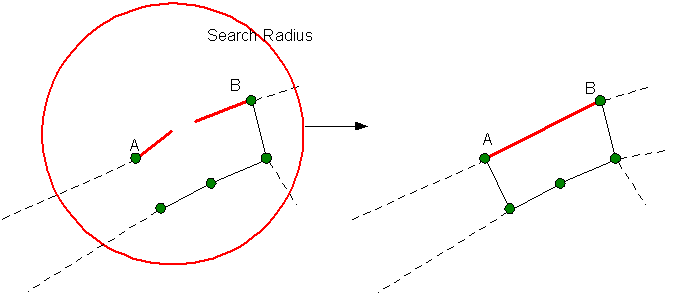Inference Rules - Proximity Testing (Collection)
Missing network parameters can be inferred from existing data, allowing gaps in the data to be filled with reasonable values.
Inference data is edited on the Inference Data Editor.
The Inference Data Editor can also be used to carry out a proximity test to automatically merge pipes to aid in resolving connectivity problems often found during the data cleanup process.
The Merge Unknown Ends rule is used to search for pairs of pipes within close proximity of one another which have opposing unknown ends and merges them into a single pipe.
|
Parameter |
Description |
|---|---|
|
Search Radius |
Search distance from unknown end of pipe to be merged. |
|
Tolerance |
Pipes will only be joined if the Height and Width of the pipes to be joined are within the specified Tolerance. |
|
Must Match Attributes |
Check the options in the Must Match Attribute options to restrict joining of pipes to pipes with the same upstream Material, Lining and/or Shape values and the same downstream Material, Lining and/or Shape values. |
The Merge Unknown Ends rule is used to search for pairs of opposing Unknown ends within a user defined Search Radius. If the pipes found satisfy defined parameters, the unknown ends of the pipes will be merged into one pipe.
- The pair of pipes to be merged must have at least one end that is not Unknown for merging to be carried out.
- Only unconnected ends of pipes with anUS Node ID / DS Node ID using an Unknown Nodes name will be considered for merging during the inference process. (See Reserved Node Names).
- When running the inference on a selection, only selected pipes will be considered for merging.
- The upstream end of a pipe will only be merged with the downstream end of another pipe, and vice versa.
- Pipes to be merged must have difference in bearing no greater than 90°.
- The Height and Width at the opposing unknown ends of the pipes to be merged must be within the Tolerance specified in the Inference Editor.
- If attributes are to be matched:
- the upstream attributes of the pipes to be merged must be equal to each other
- the downstream attributes of the pipes to be merged must be equal to each other
- If more than one pipe satisfies the merging conditions to an unknown end, the nearest pipe will be used.
Click on the image below to reveal the related example.

